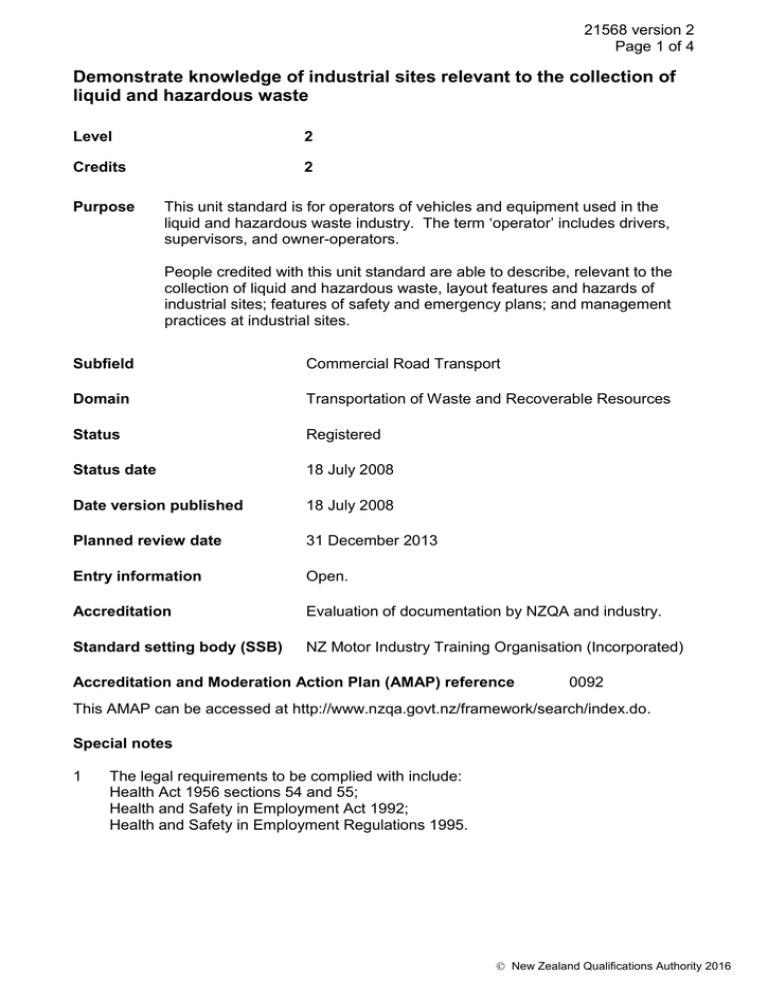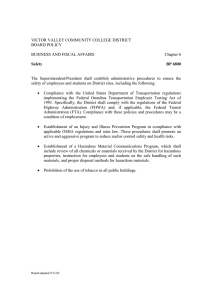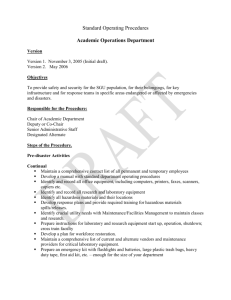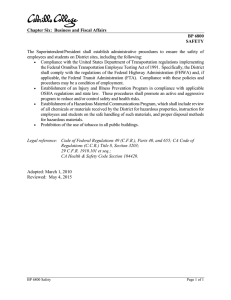Demonstrate knowledge of industrial sites relevant to the collection of
advertisement

21568 version 2 Page 1 of 4 Demonstrate knowledge of industrial sites relevant to the collection of liquid and hazardous waste Level 2 Credits 2 Purpose This unit standard is for operators of vehicles and equipment used in the liquid and hazardous waste industry. The term ‘operator’ includes drivers, supervisors, and owner-operators. People credited with this unit standard are able to describe, relevant to the collection of liquid and hazardous waste, layout features and hazards of industrial sites; features of safety and emergency plans; and management practices at industrial sites. Subfield Commercial Road Transport Domain Transportation of Waste and Recoverable Resources Status Registered Status date 18 July 2008 Date version published 18 July 2008 Planned review date 31 December 2013 Entry information Open. Accreditation Evaluation of documentation by NZQA and industry. Standard setting body (SSB) NZ Motor Industry Training Organisation (Incorporated) Accreditation and Moderation Action Plan (AMAP) reference 0092 This AMAP can be accessed at http://www.nzqa.govt.nz/framework/search/index.do. Special notes 1 The legal requirements to be complied with include: Health Act 1956 sections 54 and 55; Health and Safety in Employment Act 1992; Health and Safety in Employment Regulations 1995. New Zealand Qualifications Authority 2016 21568 version 2 Page 2 of 4 2 Any new, amended, or replacement Acts, regulations, Rules, standards, codes of practice, Land Transport New Zealand or Transit New Zealand requirements or conditions affecting the outcome of this unit standard will take precedence for assessment purposes, pending review of this unit standard. 3 Definitions Industrial site refers to a site at which liquid and hazardous waste products are generated by industrial processes and then collected for disposal by an operator of a road transport vehicle. Liquid and hazardous waste refers to those waste products that are in a liquid or sludge state that may be collected and transported in a liquid waste vacuum tanker or packaged in containers and transported in other vehicles and which fall into one of the following categories: readily biodegradable organic material (RBOM); petroleum products and residues; solvent product and residues; inorganics including heavy metals and residues; organic materials and residues; and complex organic materials and residues and intractable materials. Organisational requirements include any legal requirements, standards, codes of practice, operational and/or site policies and procedures, industry best practice and manufacturers’ instructions. These should be available to candidates, providers, and assessors. For this unit standard organisational requirements also includes the Waste Operators Handbook which is a subset of the Liquid and Hazardous Waste Code of Practice, (Wellington, New Zealand Water and Wastes Association, 2003), available at http://www.nzwwa.org.nz. 4 While every assessment situation may not provide opportunity for evidence of every performance criterion, evidence may be obtained over a period of time on the job, over several assessment opportunities, or through other means such as attestation and the use of questioning. Elements and performance criteria Element 1 Describe layout features of industrial sites relevant to the collection of liquid and hazardous waste. Performance criteria 1.1 The layout features of an industrial site for collection of liquid and hazardous waste are described in terms of accessibility and safety issues. Range holding system(s), loading point(s). 1.2 The method for confirming the type of liquid and hazardous waste product being collected from specific holding system/s is described in accordance with organisational requirements. 1.3 The route to and from the loading point/s for the liquid and hazardous waste product collection vehicle, and an explanation of its relevance to liquid and hazardous waste collection are described in accordance with organisational requirements. New Zealand Qualifications Authority 2016 21568 version 2 Page 3 of 4 1.4 Site entry and exit points and the traffic management plan and an explanation of their relevance to liquid and hazardous waste collection are described. Element 2 Describe hazards of sites and features of safety and emergency plans relevant to the collection of liquid and hazardous waste. Performance criteria 2.1 Site hazards and their impact on managing risks are described in accordance with operational requirements. Range 2.2 may include but are not limited to – personal injury or health risks, public injury or health risks, property damage or destruction risks, environmental risks. Features of safety and emergency management plan/s and procedures, and an explanation of their relevance to liquid and hazardous waste collection are described. Element 3 Describe management practices at industrial sites relevant to the collection of liquid and hazardous waste. Range site entry, site exit. Performance criteria 3.1 Site visitor and vehicle sign-in and departure control requirements and an explanation of their relevance to liquid and hazardous waste collection are described. Range site entry, site exit. 3.2 The site representative with respect to liquid and hazardous waste product collection, and an explanation of the relevance of this knowledge to liquid and hazardous waste collection is described. 3.3 The need to meet specific site requirements for documenting the vehicle load, and an explanation of the relevance of this to liquid and hazardous waste collection is described. Please note Providers must be accredited by NZQA, or an inter-institutional body with delegated authority for quality assurance, before they can report credits from assessment against unit standards or deliver courses of study leading to that assessment. New Zealand Qualifications Authority 2016 21568 version 2 Page 4 of 4 Industry Training Organisations must be accredited by NZQA before they can register credits from assessment against unit standards. Accredited providers and Industry Training Organisations assessing against unit standards must engage with the moderation system that applies to those standards. Accreditation requirements and an outline of the moderation system that applies to this standard are outlined in the Accreditation and Moderation Action Plan (AMAP). The AMAP also includes useful information about special requirements for organisations wishing to develop education and training programmes, such as minimum qualifications for tutors and assessors, and special resource requirements. Comments on this unit standard Please contact the NZ Motor Industry Training Organisation (Incorporated) info@mito.org.nz if you wish to suggest changes to the content of this unit standard. New Zealand Qualifications Authority 2016


